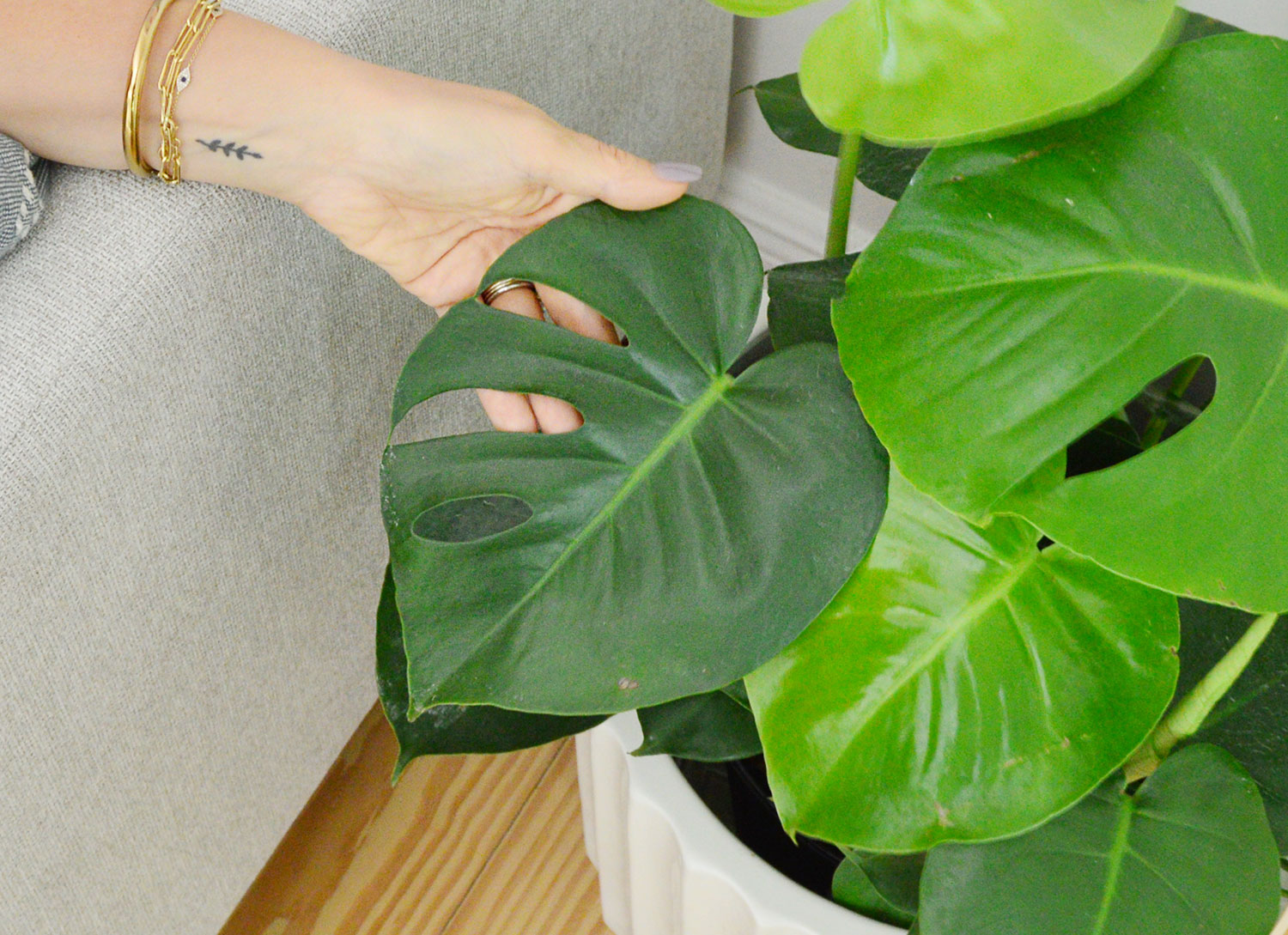Monsteras are one of the most iconic indoor houseplants today and for good reason. They’re an eye-catching, low-maintenance tropical plant that looks great in any space. Our monsteras are still low and bushy, but they’re climbing plants that can grow tall & tree-like too. Here’s why we chose this easy plant for our home.


The genus monstera includes over 50 different species of plants, most known for their large “monster” leaves with distinct holes and split edges. Today we’ll talk about the most popular houseplant variety of monstera: the monstera deliciosa.
What Is A Monstera Deliciosa?
Monsteras are native to the tropical environments of Central America, especially Mexico. Their large, distinct leaves are a natural adaptation to survive in the rainforest. The splits and holes in its leaves (called “fenestrations”) allow the plant to grow larger without getting too heavy, while also allowing sunlight and rain to reach lower parts of the plant.
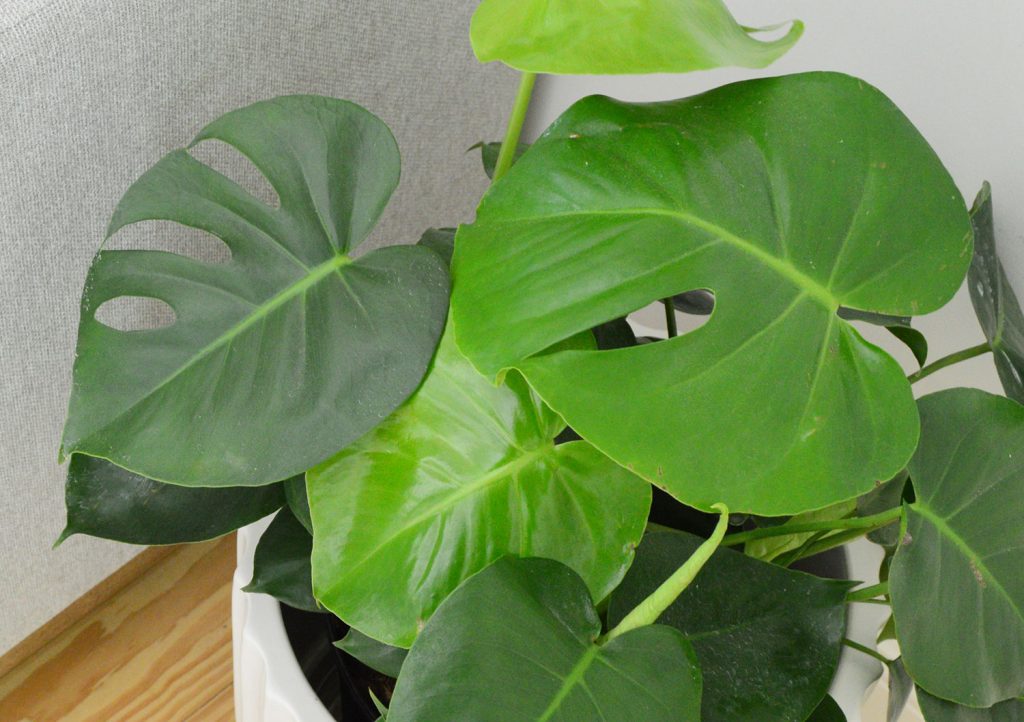

In the wild, monstera plants also grow tasty fruit (that’s where the “deliciosa” part of its name comes from) but they rarely produce fruit as indoor houseplants. It’s also considered an epiphyte, which are plants that grow on or up other plants, like trees, without harming its host. Pothos is another popular epiphyte houseplant. That’s why many people use stakes to give their monsteras something to climb.
Monstera Deliciosa vs Split Leaf Philodendron
Monstera deliciosas are also called “Swiss Cheese Plants” or “Split-leaf Philodendrons.” However, a monstera is not a philodendron and that name can cause it to be confused with a Tree Philodendron. These are two entirely different houseplants often sold under the Split Leaf Philodendron name. As you can see below, a monstera’s leaves tend to be glossier and less frilled along the edges.
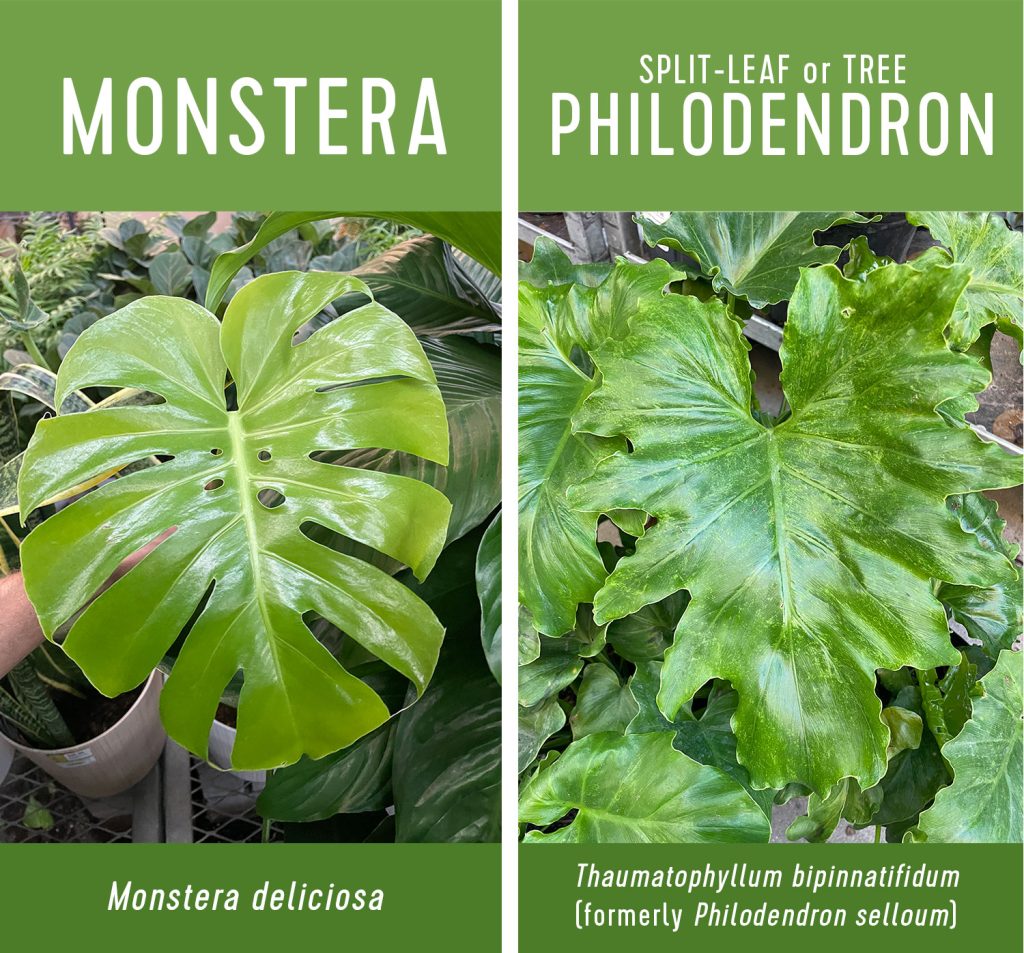

These visual distinctions may be less obvious in younger or smaller plants, so we recommended double-checking the label or listing for the plant’s scientific name. That way you’ll get the “split-leaf philodendron” you wanted!
How to Care For Monstera Deliciosa
We have no patience for finicky or difficult houseplants, which is why we love having monsteras! They are easy to care for and grow relatively fast, making them a rewarding plant to have around.
Light & Placement
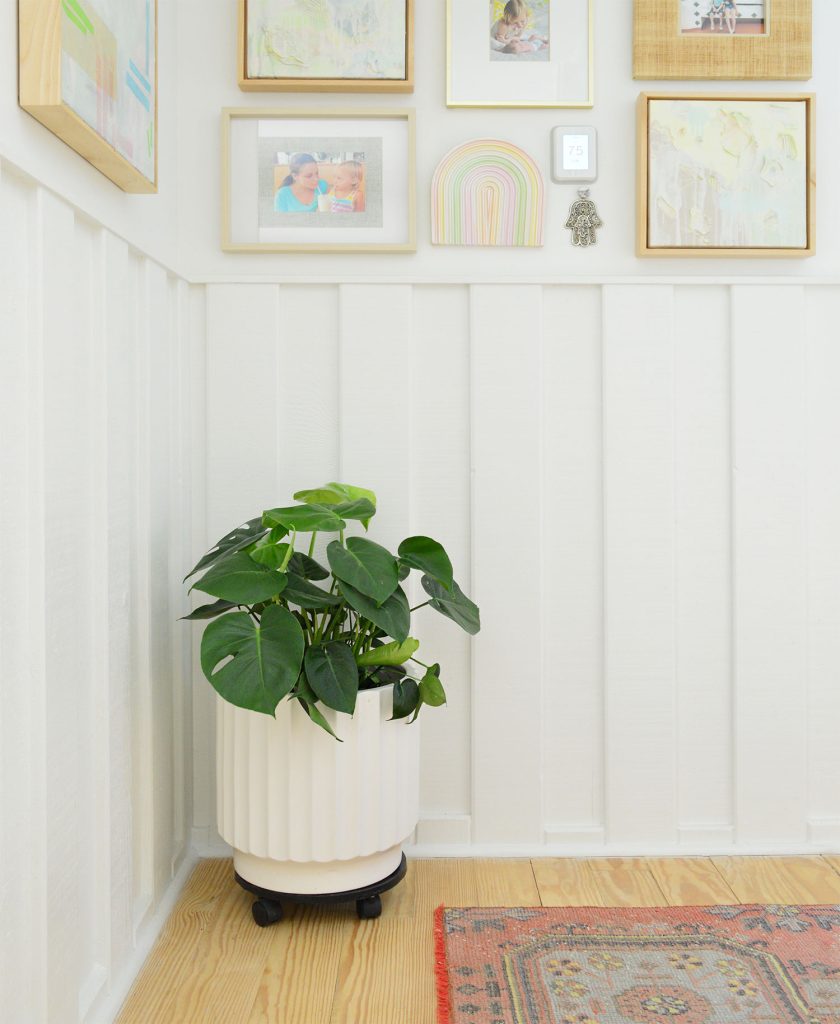

Monsteras prefer medium indirect sunlight but can adapt to a range of lighting situations. Just avoid direct sunlight because it can burn the leaves. We have one thriving in a relatively low-light hallway, but you may want a location with partial or dappled sunlight if you’re trying to encourage quicker growth.
Watering Your Monstera
Monsteras typically only need watering every 1-2 weeks during their growing season (spring & summer). Because they are rainforest plants, monsteras are accustomed to dry spells between heavy rains. So don’t worry if your soil fully dries out between waterings. You can also space out your watering even further in the fall & winter.
Humidity & Misting
Monsteras love humidity, thanks to their tropical origins. An indoor humidity of 50-60% is ideal, which means they will do well in most home environments. You can always keep it near a portable humidifier or lightly mist the leaves between waterings to encourage growth.
Cleaning Leaves
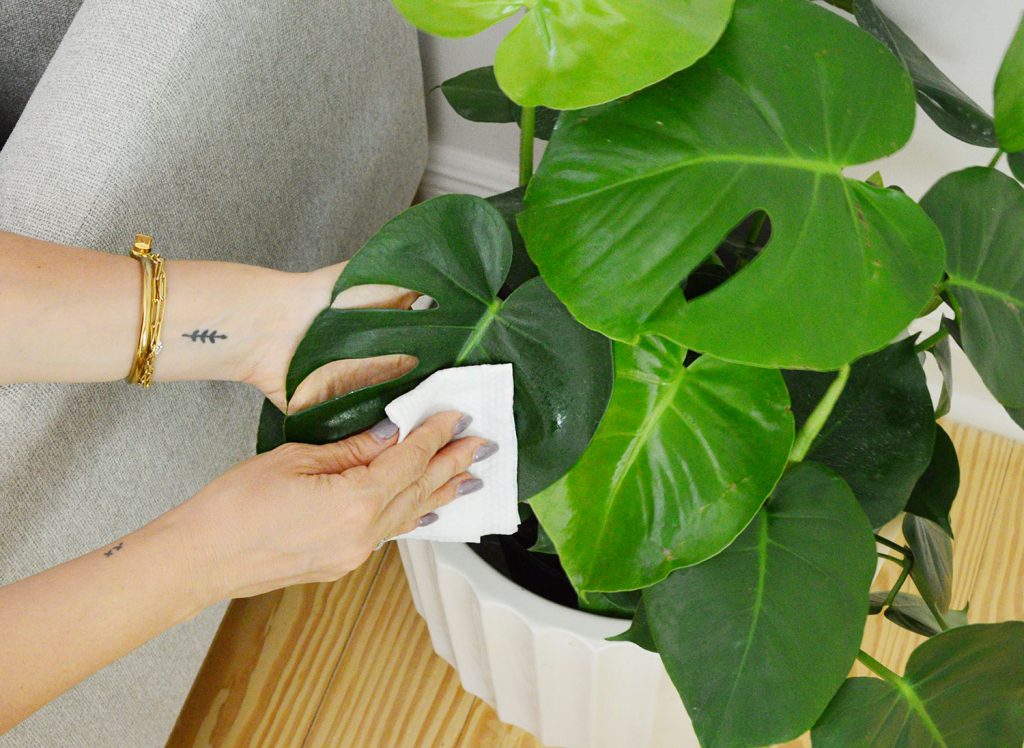

Consider wiping or dusting your monsteras leaves with a damp cloth as needed. This helps it look its best, while also allowing more sunlight onto its surface. You can also purchase plant wipes or spray to really make them shine!
Repotting a Monstera
Your monstera will likely outgrow its pot every 1-2 years. Consider repotting it into a larger, well-drained pot with fresh potting soil to encourage its continued growth. If you want to reuse the same spot, use this time to prune back growth, remove dead roots, and provide your plant with fresh, nutrient-filled soil.
Staking a Monstera
Since monsters are natural climbers, you can introduce a plant stake to encourage upward growth. Stakes are sold in a variety of sizes, shapes, and materials. Just be sure to choose one appropriate for the size and weight of your plant. Use plant tape or ties to secure it to the stake.
Common Problems
Monstera deliciosa plants are easy to care for, but don’t be surprised if you encounter one of these common issues. Luckily, they’re easy to spot and simple to address.
- Brown tips: Your monstera is getting too much sun, causing the leaves to burn. Move to a new location with softer, more indirect light.
- Yellow leaves: You’re overwatering your monstera. Let the soil fully dry out and allow more time between waterings. You can always check the soil before adding water. If it is still moist, wait longer to water.
- Pests: If you notice small pests, webs, or damage to your monstera leaves, you may have common pests like sap-sucking mealybugs, aphids, scale insects, spider mites, or more. Remove the pests with a damp cloth and apply neem oil to the base of the plant.
Other Monstera Deliciosa FAQs
Are monsteras toxic to cats?
Monstera leaves are poisonous to cats, dogs, and humans if ingested. It is safest to keep them out of reach of small children or pets who like to nibble on your houseplants. Luckily, our dog has zero interest in our plants.
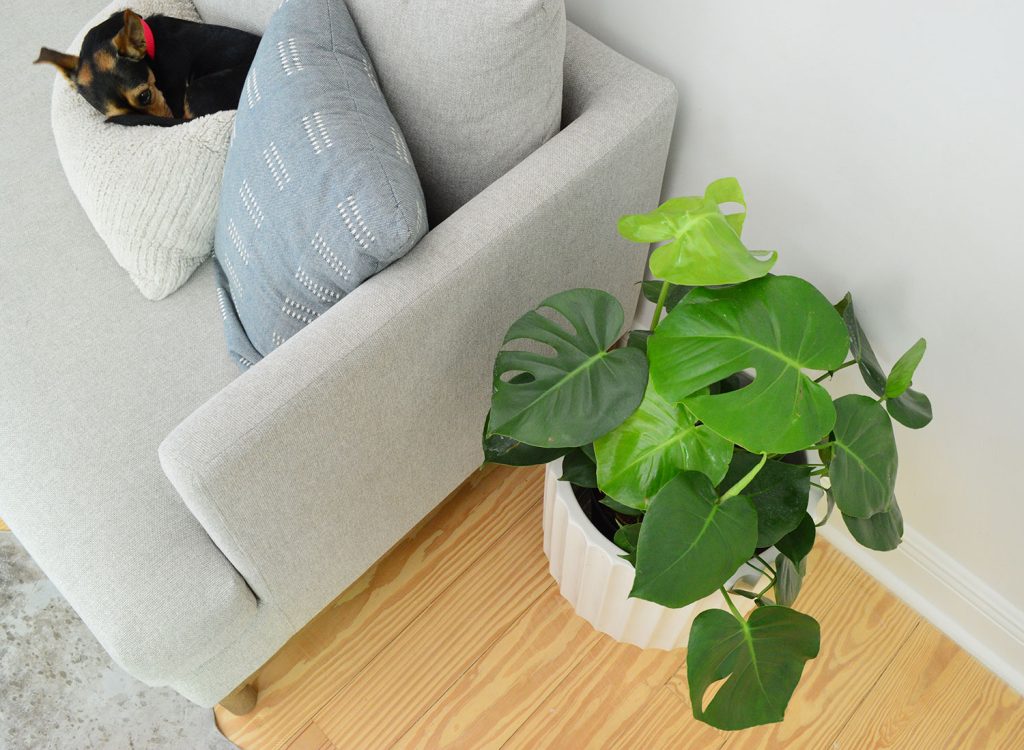

Can you propagate a monstera?
Monsteras are great plants for propagation. Use clean, sharp shears to cut a mature leaf or stalk just below its node (where the leaf stem or aerial root meets the stalk). Once the cut has a few minutes to dry out, submerge the cut end in water in a clear vessel. Place the vessel in a bright spot and change the water weekly. You can even put several cuttings in the same vase for decorative arrangement or centerpiece. You should see new roots within a few weeks and, after a couple of month, you can transfer the roots into a pot with soil.
Can I grow monstera outdoors?
Monsteras can be grown outdoors in USDA Plant Hardiness Zones 10-12, which unfortunately excludes most of the continental United States (except for areas of South Florida and coastal Southern California). If you live in one of these zones, plant your monstera in a location with partial, filtered sunlight.
More Plant Guides
If you’re looking for more information on some of our favorite plants (real and faux!) check out some of these posts below:
*This post contains affiliate links, so we may earn a small commission when you make a purchase through links on our site at no additional cost to you.

